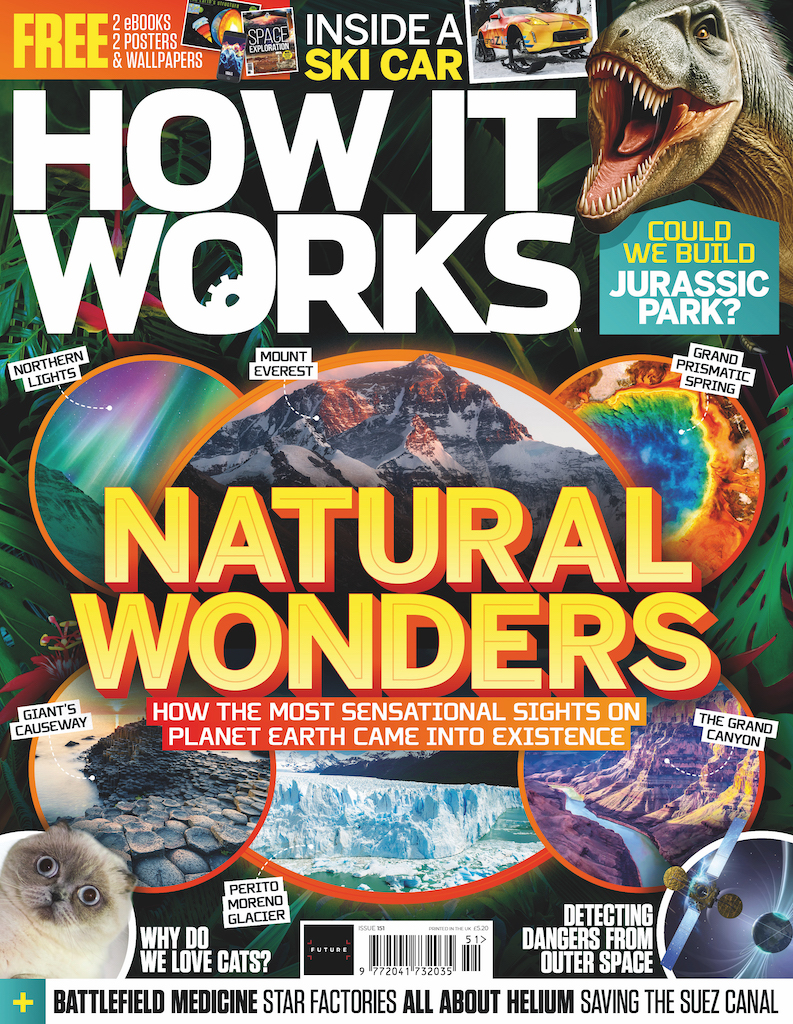What is time?
Time is all around us, but how exactly does it work?

From the beginning of the universe to the present day, time is one of the few things we regard as regular and unchanging. Time works by measuring periods between the past, present and future.
But that's a simple, albeit vague answer to an incredibly complex topic.
Time is all around us and is the basis of how we record life on Earth. Civilizations rise and fall, stars are born and extinguished, and our method of tracking how those moments relate to the present remains unchanged. But time is not as constant nor as simple as it may seem.
Related: World clock: What is it and how does it work?

This article is brought to you by How It Works.
How It Works is the action-packed magazine that's bursting with exciting information about the latest advances in science and technology, featuring everything you need to know about how the world around you — and the universe — works.
In the 17th century, physicist Isaac Newton saw time as an arrow fired from a bow, traveling in a direct, straight line and never deviating from its path. To Newton, one second on Earth was the same length of time as that same second on Mars, Jupiter or in deep space. He believed that absolute motion could not be detected, which meant that nothing in the universe had a constant speed, even light. By applying this theory, he was able to assume that if the speed of light could vary, then time must be constant. Time must tick from one second to the next, with no difference between the length of any two seconds. This is something that it's easy to think is true. Every day has roughly 24 hours; you don't have one day with 26 and one with 23.
However, in 1905, Albert Einstein asserted that the speed of light doesn't vary, but is a constant, traveling at 186,282 miles per second (299,792 kilometers per second). He postulated that time was more like a river, ebbing and flowing depending on the effects of gravity and space-time. Time would speed up and slow down around cosmological bodies with different masses and velocities, and therefore one second on Earth was not the same length of time everywhere in the universe.
Related story: What is space-time?
Breaking space news, the latest updates on rocket launches, skywatching events and more!
Decades later, Einstein's theory was proven to be true. In October 1971, physicists J.C. Hafele and Richard Keating tested Einstein's theory by flying four cesium atomic clocks on planes around the world, going eastwards and then westwards.
In their paper published in 1972 in the journal Science, Hafele and Keating reported that the airborne clocks were about 59 nanoseconds slower than a ground-based atomic clock when traveling east, and 273 nanoseconds faster than the ground-based version when traveling west. Their results supported Einstein's theory that time fluctuates throughout the universe.
How long is a second?
There are two main ways of measuring time: dynamic and atomic time. The former relies on the motion of celestial bodies, including Earth, to keep track of time, whether it's the rotation time of a distant spinning star such as a pulsar, the motion of a star across our night sky or the rotation of Earth. However, a spinning star notwithstanding, these methods are not always entirely accurate.
The old definition of a second was based on the rotation of Earth. As it takes the sun one day to rise in the east, set in the west and rise again, a day was almost arbitrarily divided into 24 hours, an hour into 60 minutes and a minute into 60 seconds. However, Earth doesn't rotate uniformly. Its rotation decreases at a rate of about 30 seconds every 10,000 years due to factors such as tidal friction. Scientists have devised ways to account for the changing speed of Earth's rotation, introducing leap seconds, but for the most accurate time you have to go even smaller.
Atomic time relies on the energy transition within an atom of a certain element, commonly cesium. By defining a second using the number of these transitions, time can be measured with an accuracy of losing a tiny portion of a second in a million years. The definition of a second is now defined as 9,192,631,770 transitions within a cesium atom, Scientific American reported.
Atomic clocks: The most accurate track of time
Atomic clocks provide the most accurate track of time on Earth. The entire GPS system in orbit around Earth uses atomic clocks to accurately track positions and relay data to the planet, while entire scientific centers are set up to calculate the most accurate measure of time — usually by measuring transitions within a cesium atom.
Related story: NASA just activated its deep space atomic clock
While most atomic clocks rely on magnetic fields, modern clocks are using lasers to track and detect energy transitions within cesium atoms and keep a more definite measure of time. Although cesium clocks are currently used to keep time around the world, strontium clocks promise twice as much accuracy, while an experimental design based on charged mercury atoms could reduce discrepancies even further to less than one second lost or gained in 400 million years.
Time: The fourth dimension of the universe
Scientists once thought that space and time were separate, and that the universe was merely an assortment of cosmic bodies arranged in three dimensions. Einstein, however, introduced the concept of time as the fourth dimension, which meant that space and time were inextricably linked. His general theory of relativity suggests that space-time expands and contracts depending on the momentum and mass of nearby matter.
Many years after its proposal, Einstein's theory of general relativity was proven thanks to NASA's Gravity Probe B, which demonstrated that space and time were indeed linked. Four gyroscopes were pointed in the direction of a distant star, and if gravity did not have an effect on space and time, they would remain locked in the same position. However, scientists clearly observed a "frame-dragging" effect due to the gravity of Earth, which meant the gyroscopes were pulled very slightly out of position. This suggests that the fabric of space can be altered, and if space and time are linked, then time can be stretched and contracted by gravity.
Related: NASA gravity probe confirms two Einstein theories
Why time moves only forward
Although Newton and Einstein came up with conflicting theories to explain how time works, both scholars agreed that time moves only forward. So far, there is no physical evidence that anything in the universe can dodge time and move backwards nor jump ahead. And scientists aren't entirely sure why time moves only forward, but they have theories.
One theory relies on the second law of thermodynamics. This law states that everything in the universe tends to move from low to high entropy, or from uniformity to disorder, beginning with simplicity at the Big Bang and moving to the almost random arrangement of galaxies and their inhabitants in the present day. This is known as the "arrow of time," or sometimes "time's arrow," likely coined by British astronomer Arthur Eddington in 1928, analytic philosopher Huw Price said at Séminaire Poincaré in 2006.
Eddington suggested that time was not symmetrical: "If as we follow the arrow we find more and more of the random element in the state of the world, then the arrow is pointing towards the future; if the random element decreases, the arrow points towards the past," he wrote in "The Nature of the Physical World" in 1928. For example, if you were to observe a star in almost uniformity, but later saw it explode as a supernova and become a scattered nebula, you would know that time had moved forward from equality to chaos.
Another theory suggests that the passage of time is due to our expanding universe. As the universe expands, it pulls time with it because space and time are linked as one. But this implies that if the universe were to reach a theoretical limit of expansion and begin to contract, then time would reverse — a slight paradox. Could time really move backwards, with everything coming back to an era of simplicity and ending with a "Big Crunch"? It's unlikely we'll be around to find out, but we can postulate on what we think might happen.
Scientists may not have all the answers, but over the past century they've made impressive progress in understanding how time works. From ancient time-telling sundials to modern atomic clocks, we can now track the passing of a second more closely than ever before. Time remains a complex topic, but thanks to scientific visionaries, we are getting closer to unlocking the secrets of this not-so-constant universal constant.
Additional resources and reading
To learn more about the concept of time dilation, which we didn't dive into much here, check out this explainer from the University of Mississippi. There are numerous videos on YouTube that may help you visualize the concept of time and how it works. Here is a great one from the National Institutes of Standards and Technology. Learn more about how time continues to stump even the best physicists in the world in "The Order of Time" by Carlo Rivelli (Riverhead Books, 2018).
Bibliography
- Ramsey, Norman F. “History of Atomic Clocks.” Journal of research of the National Bureau of Standards (1977) vol. 88,5 (1983): 301-320. doi:10.6028/jres.088.015
- Eddington, A. S. (1933). The expanding universe. Nature, 132(3332), 406-407. https://ps.ucw.cz/typeset/eddington.pdf
- Price, Huw. "Time's Arrow and Eddington's Challenge," Séminaire Poincaré XV Le Temps (2010) 115 – 140. http://www.bourbaphy.fr/price.pdf

Jonathan O’Callaghan is a freelance space and science journalist based in the UK, regularly writing and reporting for a number of publications around the world. He specialises in covering commercial spaceflight, space exploration, and astrophysics, but also reports across a wide range of science, from CRISPR to climate change.
